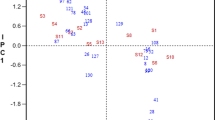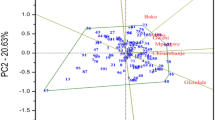Abstract
There is a need to develop the next generation of healthier crop products for an improved human and animal nutrition. Maize (Zea mays L.) cultivars with improved amino acid profiles are essential to diets focused on this crop. Breeders have added crop value with the development of quality protein maize (QPM). However, QPM cultivars have never been an option to farmer and ranchers in short-season environments. The objectives of this research were: (1) to adapt QPM genotypes to the northern U.S. through the North Dakota (ND) EarlyQPM Program, and (2) to develop new early generation SS and non-SS short-season QPM lines and populations for breeding purposes. Fifty-three inbred lines, including 47 QPM donor lines, five experimental North Dakota State University (NDSU) lines, and one ex-PVP line from industry, were selected to produce 94 early-QPM backcross populations. Considering earliness, protein content, and amino acid levels, 218 early generation lines were selected for producing testcrosses with industry testers. Experiments evaluating testcrosses were arranged in 10 × 10 and 12 × 12 partially balanced lattice designs across three ND locations in 2013 and 2014. A total of 48 lines were selected for further development, 17 representing the Stiff Stalk (SS) heterotic group and 31 representing the non-SS group. Selected lines showed, in hybrid combinations, not only above average grain yield, rate of dry down, and total protein content but also high levels of lysine, tryptophan, and methionine essential amino acids for feedstock nutrition. The results of this research show, for the first time, the successful adaptation of QPM genotypes to short-season environments. As a result, new ND EarlyQPM germplasms and lines have been developed for potential release.
Similar content being viewed by others
References
Bjarnason M, Vasal SK (1992) Breeding of quality protein maize (QPM). Plant Breed Rev 9:181–216
Bressani R (1992) Nutritional value of high-lysine maize in humans. In: Mertz ET (ed) Quality protein maize. American Association of Cereal Chemists, St. Paul
Carena MJ (2003) ‘EarlyGEM’: incorporating GEM elite lines in early maize. In: GEM Public Cooperator Report http://www.public.iastate.edu/~usda-gem/Public_Reports/GEM_PR_03.htm, Ames, IA
Carena MJ (2013a) Developing cold and drought tolerant short-season maize products for fuel and feed utilization. Crop Breed Appl Biotech 13:1–8
Carena MJ (2013b) Developing the next generation of diverse and healthier maize cultivars tolerant to climate changes. Euphytica 190:471–479
Cook JP, McMullen MD, Holland JB, Tian F, Bradbury P, Ross-Ibarra J, Buckler ES, Flint-Garcia SA (2012) Genetic architecture of maize kernel composition in the nested association mapping and inbred association panels. Plant Physiol 158:824–834
Crow JF, Kermicle J (2002) Oliver Nelson and quality protein maize. Genetics 160:819
Dong N, Laude T, Carena MJ (2012) The NDSU EarlyQPM program: the next generation of healthier short-season products. In 2012 Corn Utilization and Technology Conference, Indianapolis
Dudley JW, Lambert RJ (2004) 100 generations of selection for oil and protein in corn. Plant Breed Rev 24:79–110
Gevers HO, Lake JK (1992) Development of modified opaque-2 maize in South Africa. In: Mertz ET (ed) Quality protein maize. American Association of Cereal Chemists, St. Paul, pp 49–78
Gibbon BC, Larkins BA (2005) Molecular genetic approaches to developing quality protein maize. Trends Genet 21:227–233
Gomez KA, Gomez AA (1984) Statistical procedures for agricultural research, 2nd edn. Wiley, New York
Hallauer AR, Carena MJ (2009) Maize breeding. In: Carena MJ (ed) Handbook of plant breeding: cereals. Springer, New York, pp 3–98
Hallauer AR, Carena MJ, Miranda Filho JB (2010) Quantitative genetics in maize breeding. Springer, New York
Laude TP, Carena MJ (2014) Diallel analyses among 16 maize populations adapted to the northern U.S. Corn Belt for grain yield and grain quality traits. Euphytica 200:29–44
Lopes MA, Larkins BA (1995) Molecular biology and traditional breeding applied to the improvement of maize nutritional quality. In: Sobral BWS (ed) The impact of plant molecular genetics. Birkhauser, Boston, pp 273–296
Mertz ET, Bates LS, Nelson OE (1964) Mutant gene that changes protein composition and increases lysine content of maize endosperm. Science 145:279
Osborne TB, Mendel LB (1914) Nutritive properties of maize kernel. J Biol Chem 18:1–16
Pollak LM, Scott MP (2005) Breeding for grain quality traits. Maydica 50:247–257
Prasanna BM, Vasal SK, Kassahun B, Singh NN (2001) Quality protein maize. Current Sci 81:1308–1319
SAS (1990) SAS user’s guide: statistics, 4th edn. SAS Inst. Inc., Cary
Scott MP, Bhatnager S, Betran J (2004) Tryptophan and methionine levels in quality protein maize breeding germplasm. Maydica 49:303–311
Scott MP, Edwards JW, Bell CP, Schussler JR, Smith JSC (2006) Grain composition and amino acid content en maize cultivars representing 80 years of commercial maize varieties. Maydica 51:417–423
Sharma S, Carena MJ (2012) NDSU EarlyGEM: Incorporating tropical and temperate elite exotic germplasm to increase the genetic diversity of short season maize. Maydica 57:34–42
Vasal SK (2000) The quality protein maize story. Food Nutr Bull 21:445–450
Vasal SK (2001) High quality protein corn. In: Hallauer AR (ed) Specialty corns. CRC Press, Boca Raton, pp 85–129
Vasal SK (2002) Quality protein maize: overcoming the hurdles. J Crop Prod 6:193–227
Vietmeyer ND (2000) A drama in three long acts: the story behind the story of the development of quality-protein maize. Diversity 16:29–32
Villegas E, Vasal SK, Bjarnason M (1992) Quality protein maize—what is it and how was it developed. In: Mertz ET (ed) Quality protein maize. American Association of Cereal Chemists, St. Paul, pp 27–48
Vivek BS, Krivanek AF, Palacios-Rojas N, Twumasi-Afriyie S, Diallo AO (2008) Breeding quality protein maize (QPM): protocols for developing QPM cultivars. CIMMYT, Mexico
Worral HM, Scott P, Hallauer AR (2015) Registration of temperate quality protein maize (QPM) Lines BQPM9, BQPM10, BQPM11, BQPM12, BQPM13, BQPM14, BQPM15, BQPM16, and BQPM17. J Plant Reg 9:371–375
Yang J, Carena MJ, Uphaus J (2010) AUDDC: a method to evaluate rate of dry down in maize. Crop Sci 50:1–8
Zuber MS, Helm JL (1975) Approaches to improving protein quality in maize without the use of specific mutants, in high-quality protein maize. Hutchinson Ross Publishing, Stroudsburg, p 241
Acknowledgements
The research was partially supported by the North Dakota Corn Utilization Council, the North Dakota Agricultural Products Utilization Council, and the Minnesota Corn Research & Promotion Council.
Author information
Authors and Affiliations
Corresponding author
Rights and permissions
About this article
Cite this article
Carena, M.J., Dong, N. The ND EarlyQPM program: developing the next generation of healthier maize (Zea mays L.) products. Euphytica 213, 150 (2017). https://doi.org/10.1007/s10681-017-1937-x
Received:
Accepted:
Published:
DOI: https://doi.org/10.1007/s10681-017-1937-x




